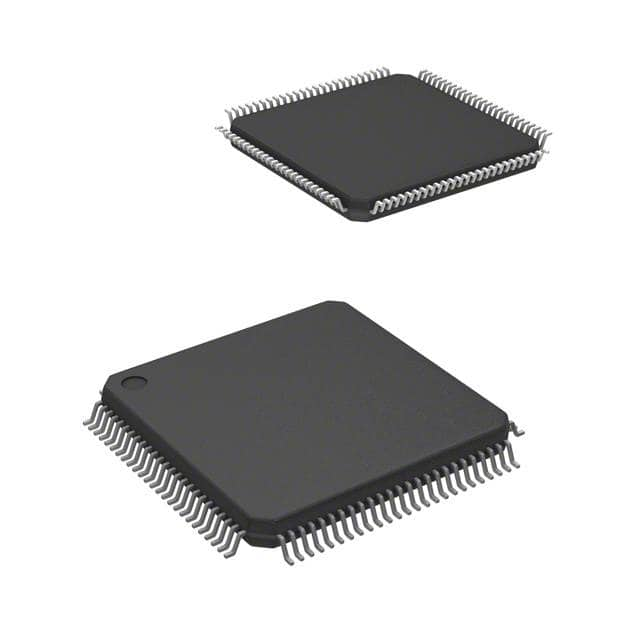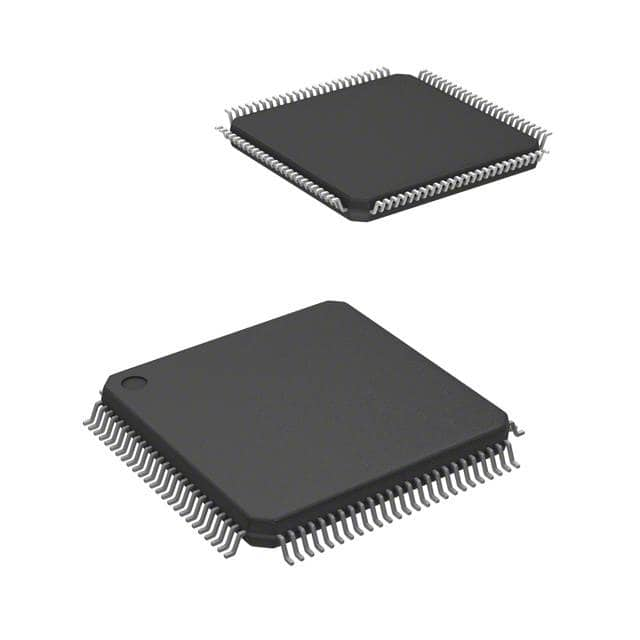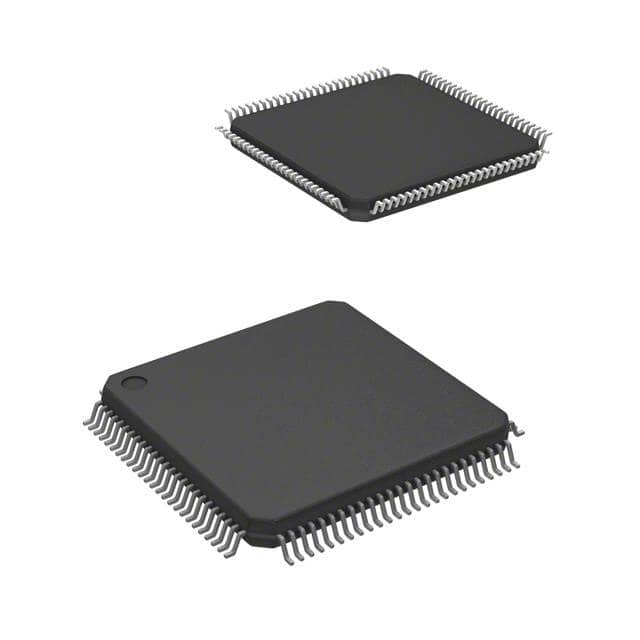STMicroelectronics STM32F105VCT6
STM32F105VCT6 Introduction
STM32F105VCT6 is a member of STMicroelectronics' STM32F1 series of microcontrollers, based on the ARM Cortex-M3 core. It is designed to provide a balance of high performance, power efficiency, and peripheral integration, making it suitable for a wide variety of embedded applications in industrial, automotive, consumer, and networking devices.
Typical Applications:
Industrial Control: The STM32F105VCT6 is ideal for automation, motor control, and machinery systems that require real-time processing, precise timing, and high-speed communication.
Consumer Electronics: This microcontroller is used in products such as home automation systems, remote controls, audio systems, and small appliances.
Automotive: The CAN bus support allows the STM32F105VCT6 to be used in automotive applications, such as sensor interfaces and communication between microcontrollers in vehicles.
Communication Systems: Its USB, UART, SPI, and I2C interfaces make it suitable for embedded systems that require communication with peripherals or other systems.
Energy-Efficient Devices: Due to its low power consumption and various sleep modes, the STM32F105VCT6 is suitable for battery-operated devices or energy-efficient applications.
STM32F105VCT6 Parameters
STM32F105VCT6 Similar Prodcuts Comparison
STM32F103VET6 vs STM32F105VBT6 vs STM32F107VBT6 vs STM32F105VCT6
| Parameter | STM32F103VET6 | STM32F105VBT6 | STM32F107VBT6 | STM32F105VCT6 |
|---|---|---|---|---|
| image |  |  |  |  |
| Manufacturer | STMicroelectronics | STMicroelectronics | STMicroelectronics | STMicroelectronics |
| Core | ARM Cortex-M3 | ARM Cortex-M3 | ARM Cortex-M3 | ARM Cortex-M3 |
| Max Clock Frequency | 72 MHz | 72 MHz | 72 MHz | 72 MHz |
| Flash Memory | 512 KB | 128 KB | 128 KB | 256 KB |
| SRAM | 64 KB | 64 KB | 64 KB | 64 KB |
| GPIO Pins | 80 GPIO pins | 80 GPIO pins | 80 GPIO pins | 80 GPIO pins |
| Package Typ | LQFP100 | LQFP100 | LQFP100 | LQFP100 |
| Timers | 3 general-purpose, 1 advanced, 2 basic | 4 general-purpose, 1 basic | 4 general-purpose, 1 basic | 4 general-purpose, 1 basic |
| ADC | 2 x 12-bit ADCs (16 channels) | 2 x 12-bit ADCs (16 channels) | 2 x 12-bit ADCs (16 channels) | 2 x 12-bit ADCs (16 channels) |
| DAC | 1 x 12-bit DAC | 1 x 12-bit DAC | 1 x 12-bit DAC | 1 x 12-bit DAC |
| USART | 5 USARTs | 3 USARTs | 3 USARTs | 3 USARTs |
| SPI | 3 SPIs | 2 SPIs | 2 SPIs | 2 SPIs |
| I2C | 2 I2C interfaces | 2 I2C interfaces | 2 I2C interfaces | 2 I2C interfaces |
| USB Interface | Full-Speed USB | Full-Speed USB OTG FS | Full-Speed USB OTG FS | Full-Speed USB OTG FS |
| CAN | 1 CAN bus interface | 2 CAN bus interface | 2 CAN bus interface | 2 CAN bus interface |
| Ethernet Interface | No | No | 1 Ethernet MAC interface | No |
| DMA Channels | 7 DMA channels | 7 DMA channels | 7 DMA channels | 7 DMA channels |
| Watchdog | Independent and Window Watchdog | Independent and Window Watchdog | Independent and Window Watchdog | Independent and Window Watchdog |
| Low Power Modes | Sleep, Stop, and Standby | Sleep, Stop, and Standby | Sleep, Stop, and Standby | Sleep, Stop, and Standby |
| Operating Voltage | 2.0V - 3.6V | 2.0V - 3.6V | 2.0V - 3.6V | 2.0V - 3.6V |
| Operating Temperature | -40°C to 85°C | -40°C to 85°C | -40°C to 85°C | -40°C to 85°C |
| Debug Interface | JTAG and SWD | JTAG and SWD | JTAG and SWD | JTAG and SWD |
| CRC Unit | Supported | Supported | Supported | Supported |
STM32F105VCT6 PDF Datasheet
STM32F103VCT6 FAQs
1. What is the core architecture of the STM32F105VCT6?
The STM32F105VCT6 is based on the ARM Cortex-M3 core, which is a 32-bit RISC (Reduced Instruction Set Computing) processor designed for high performance, low power consumption, and real-time processing.
2. What is the clock speed of the STM32F105VCT6?
The STM32F105VCT6 operates at a maximum clock speed of 72 MHz, offering sufficient processing power for most embedded applications requiring moderate processing performance.
3. What is the flash memory and RAM capacity of the STM32F105VCT6?
The STM32F105VCT6 comes with 128 KB of Flash memory for storing program code, and 16 KB of SRAM for data storage during program execution.
4. What are the main peripherals available in the STM32F105VCT6?
The STM32F105VCT6 includes a wide range of peripherals, such as:
5. What is the operating voltage range of the STM32F105VCT6?
The STM32F105VCT6 operates within a voltage range of 2.0V to 3.6V, which makes it suitable for low-power applications, especially in battery-powered devices.
6. What is the package type of the STM32F105VCT6?
The STM32F105VCT6 is available in the LQFP-64 (Low-Profile Quad Flat Package with 64 pins), which offers flexibility for various external devices and sensors to interface with the microcontroller.
7. What are the key features of the STM32F105VCT6?
72 MHz ARM Cortex-M3 core for fast processing.
128 KB Flash and 16 KB SRAM for code and data storage.
USB 2.0 Full-Speed and CAN interfaces for communication.
3 UARTs, 2 SPIs, and 2 I2Cs for communication with peripherals.
DMA support for efficient data transfer.
3 ADCs (12-bit, 16 channels) for analog-to-digital conversion.
Low-power modes for energy-efficient applications.
Watchdog Timer and Real-Time Clock (RTC) for system reliability.
8. What development tools are supported by the STM32F105VCT6?
The STM32F105VCT6 is supported by various development tools, including:
9. What is the temperature range of the STM32F105VCT6?
The STM32F105VCT6 has an industrial temperature range of -40°C to +85°C, making it suitable for applications in industrial environments, automotive systems, and other systems with harsh temperature conditions.
10. Can the STM32F105VCT6 be used in battery-powered applications?
Yes, the STM32F105VCT6 is suitable for battery-powered applications due to its low-power features and support for multiple low-power modes (e.g., Sleep, Stop, and Standby modes). Its operating voltage range of 2.0V to 3.6V makes it ideal for low-power systems.
11. What are the differences between STM32F105VCT6 and STM32F103VCT6?
The main difference between STM32F105VCT6 and STM32F103VCT6 is that the STM32F105VCT6 includes USB 2.0 Full-Speed and CAN support, which makes it suitable for applications that require communication protocols like USB and CAN. The STM32F103VCT6 does not have these interfaces.
12. How do I debug and program the STM32F105VCT6?
The STM32F105VCT6 supports JTAG and Serial Wire Debug (SWD) interfaces for programming and debugging. These interfaces allow you to load firmware onto the microcontroller and step through code to debug the application in real time.
13. What is the maximum operating frequency of the STM32F105VCT6?
The STM32F105VCT6 can operate at a maximum clock frequency of 72 MHz, which is sufficient for many embedded applications but not as high as more advanced STM32 families (e.g., STM32F4 or STM32F7 series).
14. What kind of applications is the STM32F105VCT6 suitable for?
The STM32F105VCT6 is suitable for a wide range of applications, including:
15. Does the STM32F105VCT6 support Ethernet?
No, the STM32F105VCT6 does not have Ethernet support. However, higher-end STM32 families, such as the STM32F107 or STM32F407 series, support Ethernet for networking applications.
STMicroelectronics
In Stock : 22334
